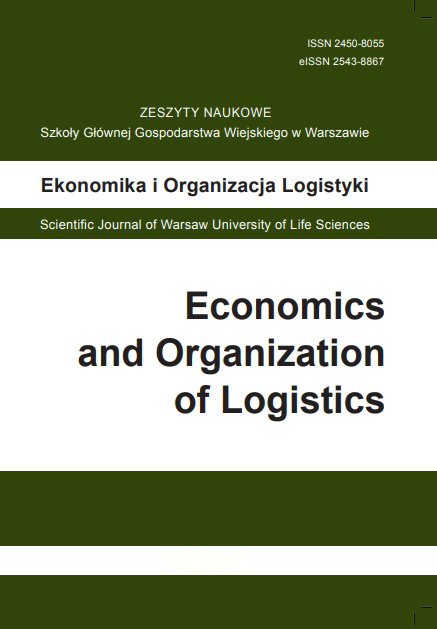Main Article Content
Article Details
Bazzazi A.A., Osanloo M, Karimi B., 2011: Deriving preference order of open pit mines equipment through MADM methods: application of modified VIKOR method, Expert Systems with Applications 38(3), 550–2556. DOI:10.1016/j.eswa.2010.08.043 (Crossref)
Bulgurcu B., 2016: Investment Destination Decision by Using the VIKOR Method in the European Union Countries, American International Journal of Contemporary Research 6(2), 16–24.
Chakraborty S., Yeh C.H., 2009: A simulation comparison of normalization procedures for TOPSIS, [in:] International Conference on Computers & Industrial Engineering IEEE, 1815–1820. (Crossref)
Chang C.L., 2010: A modified VIKOR method for multiple criteria analysis, Environmental Monitoring and Assessment 168(1–4), 339–344. DOI: 10.1007/s10661-009-1117-0 (Crossref)
Cigu E., Agheorghiesei D.T., Gavriluță (Vatamanu) A.F., Toader E., 2019: Transport Infrastructure Development, Public Performance and Long-Run Economic Growth: A Case Study for the Eu-28 Countries, Sustainability 11(67), 2–22. (Crossref)
Eurostat database, 2019: [electronic source]: https://ec.europa.eu/eurostat/data/database [access: 01.03.2020].
Hayaloglu P., 2015: The Impact of Developments in the Logistics Sector on Economic Growth: The Case of OECD Countries, International Journal of Economics and Financial Issues 5(2), 523–530.
Hellwig Z., 1968: Application of the taxonomy method in typology classification of the countries due to the development level and resources and the structure of human resources, Statistical Review 4, 307–327.
Hwang Ch.-L, Yoon K., 1981: Multiple Attribute Decision Making: Methods and Applications, Springer-Verlag, New York. (Crossref)
Ishizaka A., Nemery P., 2013: Multi-criteria decision analysis: methods and software, John Wiley & Sons, New Jersey. (Crossref)
Kaczmarczyk P., 2018: Application of the linear ordering methods in the voivodships research in the field of social media usage in enterprises in the period 2014–2017, Journal of Economics and Management 33(3), 39–62. (Crossref)
Kauf S., Tłuczak A., 2017: Analiza zróżnicowania potencjału logistycznego krajów Unii Europejskiej [The Analysis of Diversity of the Logistics Potential in EU Countries], Ekonomika Transportu i Logistyka 65, 73–82 [in Polish].
Kim Y., 2013: Fuzzy VIKOR approach for assessing the vulnerability of the water supply to climate change and variability in South Korea, Applied Mathematical Modelling 37, 22(15), 9419–9430. DOI: 10.1016/j.apm.2013.04.040 (Crossref)
Krysiuk C., Zakrzewski B., 2013: Logistics centres as element improving the EU’s transport system, TTS Technika Transportu Szynowego 20, 2277–2285.
Kukuła K., Luty L., 2015a: The proposal for the procedure supporting selection of a linear ordering method, Statistical Review 62(2), 219–231. (Crossref)
Kukuła K., Luty L., 2015b: The ranking of EU countries due to selected indicators characterizing organic farming, Quantitative Methods in Economics 16(3), 225–236.
Lai Y.-J., Liu T.-Y., Hwang C.-L., 1994: TOPSIS for MODM, European Journal of Operational Research 76(3), 486–500. (Crossref)
Opricovic S., Tzeng G.H., 2004: Compromise solution by MCDM methods: a comparative analysis of VIKOR and TOPSIS, European Journal of Operational Research 156, 45–55. (Crossref)
Roszkowska E., 2011: Multi-criteria decision making models by applying the TOPSIS method to CRISP and interval data, Multiple Criteria Decision Making 6, 200–230.
San Crist´obal, J.R., 2011: Multi-Criteria decision-making in the selection of a renewable energy project in Spain: The Vikor method, Renewable Energy 36, 498–502. (Crossref)
Sanayei A, Farid Mousavi S, Yazdankhah A., 2010: Group decision making process for supplier selection with VIKOR under fuzzy environment, Expert Systems with Applications 37, 24–30. (Crossref)
Sánchez R., 2017: Economic impact of changes in logistics infrastructure networks: two case studies in Argentina, Facilitation of Transport and Trade in Latin America and the Carribean 356(4), 1–11.
Sayadi M.K., Heydari M., Shahanaghi K., 2009: Extension of VIKOR method for decision making problem with interval numbers, Applied Mathematical Modelling 33, 2257–2262. (Crossref)
Skorobogatova O., Kuzmina-Merlino I., 2017: Transport Infrastructure Development Performance, Procedia Engineering 178, 319–329. (Crossref)
GUS 2019: Rocznik Statystyki Międzynarodowej 2019, [electronic source]: stat.gov.pl/obszary-tematyczne/roczniki-statystyczne/roczniki-statystyczne/rocznik-statystyki-miedzynarodowej-2019,10,7.html [access: 01.03.2020].
Vilko J., Karandassov B., Myller E., 2011: Logistic infrastructure and its effects on economic development, China-USA Business Review 10(11), 1152–1167.
Vulevic A., 2018: Linkage between Regional Accessibillity, Economic Development, and Logistic Infrastructure, Intelligent Transportation and Planning: Breakthroughs in Research and Practice – IGI Global, 719–744. DOI: 10.4018/978-1-5225-5210-9 (Crossref)
Yoon K., 1980: Systems selection by multiple attribute decision making, Kansas State University, Manhattan.
Downloads
- Katarzyna Łukasiewicz, Kompetencje cyfrowe w zarządzaniu łańcuchem dostaw , Ekonomika i Organizacja Logistyki: Tom 4 Nr 4 (2019)
Możesz również Rozpocznij zaawansowane wyszukiwanie podobieństw dla tego artykułu.
- Paweł Hoser, Luiza Ochnio, Komputerowe wspomaganie układania planu zajęć oparte na wybranych metodach heurystycznych , Ekonomika i Organizacja Logistyki: Tom 7 Nr 2 (2022)
- Paweł Hoser, Luiza Ochnio, Wykorzystanie systemu wieloagentowego do optymalizacji planu zajęć na uczelni , Ekonomika i Organizacja Logistyki: Tom 7 Nr 3 (2022)

Utwór dostępny jest na licencji Creative Commons Uznanie autorstwa – Użycie niekomercyjne 4.0 Międzynarodowe.





